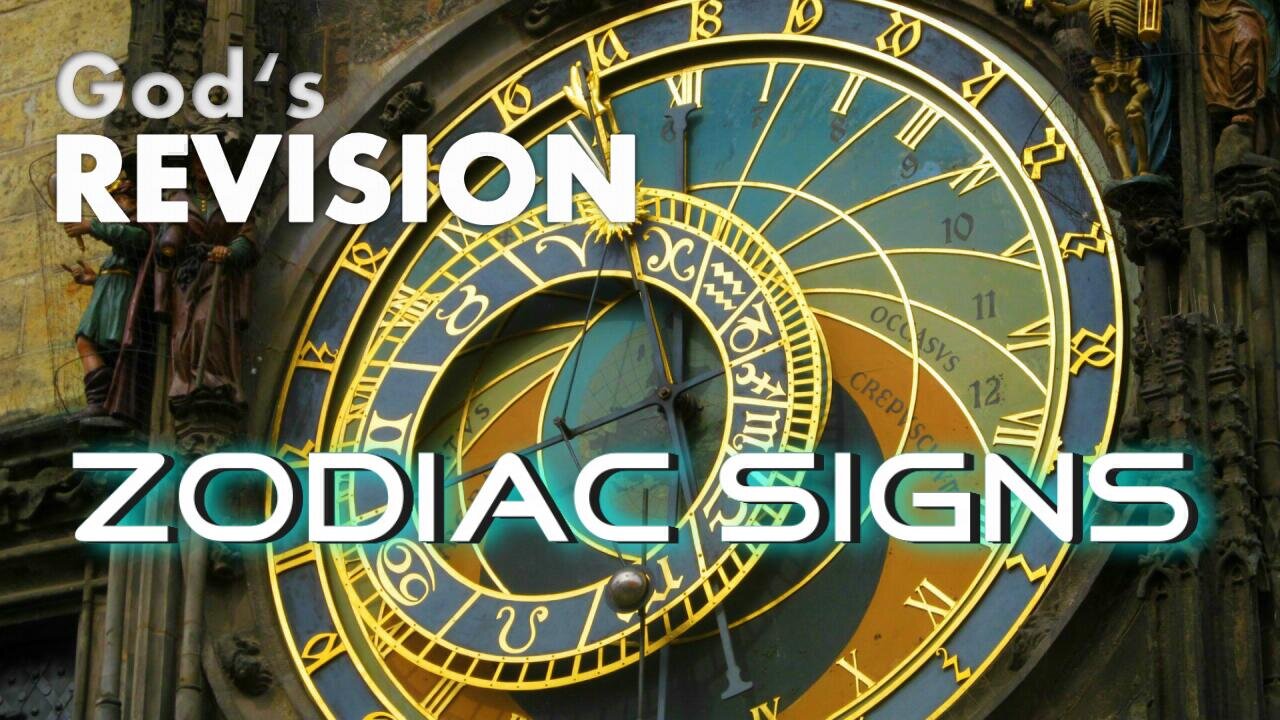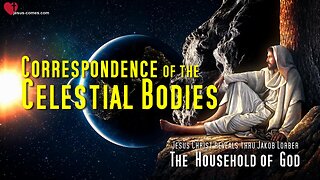Premium Only Content

Zodiac Signs explained ❤️ Jesus Christ reveals the Great Gospel of John thru Jakob Lorber
Text, Audio & Related Topics... https://jesus-comes.com/index.php/2017/07/08/sternbilder-erlautert-zodiac-signs-explained/
Channels - Kanäle... https://jesus-comes.com/index.php/2022/10/16/kanalubersicht-channel-overview/
Read Text online... https://search.jesus-comes.com/index.php?title=GGJ03-101
Video Playlist The Great Gospel of John... https://www.youtube.com/playlist?list=PLXBcyEV0LX-UgAKBBwtcSFupP9swFf9lj
The Great Gospel of John Overview & EBooks... https://jesus-comes.com/index.php/jesus-offenbart-das-grosse-johannes-evangelium-jesus-reveals-the-great-gospel-of-john-jakob-lorber/
Jesus' Revelations thru Jakob Lorber... https://jesus-comes.com/index.php/category/english/jakob-lorber-pdfs/
God’s Revision – Zodiac Signs
…also known as Star Signs, Constellations, Zodiac
In the presence of the Lord, the disciple and several hundred successors, Mathael explained to the still superstitious Greeks Ouran and his daughter Helena, whence the names of the constellations originate and what they originally meant. This important instruction should help to remove the bonds to “mysteries” …
… From “The Great Gospel of John,” Volume 3, from Chapters 101 to 105 and 107 (Jacob Lorber)
101,8. Helena asks Malthael: “Who discovered first the zodiac and gave the twelve pictures their names? Why did they receive exactly these names that we know, and why no others of a particular type and sort? What has a lion to do with a virgin, a crab with the twins, a scorpion with a balance scales, an ibex with an archer? How do a bull and a ram get into the firmament, how a fisherman with the fish?
101,9. It is very strange that in the animal world there are also four human images and the image of an object. If you can give me some reason for this you will make me very connected to you!”
101,10. Mathael says, “Oh, most blessed Helena, nothing easier than this! Just have a little patience during my explanation and the issue will become quite clear to you!”
102,1. (Mathael:) “The discoverers of the zodiac were obviously the native residents of Egypt, who for one reached a much higher age than we do, secondly had always a most pure sky and could observe the stars much more easily and constantly than we with our often thickly clouded sky, and thirdly most people slept the whole hot day through. Only in the evenings did they go out into the open and completed their work in the cool of night. There they had constantly the constellations in sight, soon noticed the unchangeable figures and gave them names which corresponded with some natural event occurring at a particular time or with a duty of the land.
102,2. Multiple observance of the zodiac led the watchers soon to the belief that the zodiac is a great circle, which is divided into twelve almost equal parts. In each of these parts there is an individual constellation.
102,3. Even the peoples of antiquity considered the stars of this Earth to be further away than the sun and the moon and therefore they let the sun along with the moon move on a path inside the great zodiac.
102,4. But the zodiac also moved in a way that the sun, which rounds the Earth every day, stopped in another sign after thirty days due to the great movement of the zodiac. But that the moon always came into another sign every couple of days, they explained from its slower daily course around the Earth, by which it never comes to the same place at the same time like the sun – therefore they often called the moon the “tardy star”.
102,5. But there were some wise men who claimed exactly the opposite of the moon; yet the teaching of the tardyness of the moon prevailed.
102,6. You see, that’s how the zodiac was created, and now you should also soon learn how the twelve constellations got their peculiar names!
102,7. In the season of the shortest days, which especially in Egypt is always accompanied by rain, (and with this easy to remember time of thirty days one always let a new year begin) according to the calculations of the elders the sun was situated exactly under the constellation that is known to us as Aquarius; therefore the constellation was first given the form of a shepherd when he comes with his water bucket to the trough created to give the domestic animals something to drink and pours the whole bucket into the drinking trough. The elders called such a person the water sprite (Uodan) and secondly they named the constellation thus and thirdly also this time. Later the vain fantasy of people soon made a god out of this good image and gave him divine honor, because it was seen to revive the withered nature – See, most blessed Helena, thus the familiar first constellation received its name and the first thirty days of rain. Let’s go to the second sign that is called Pisces!”
102,8. When Mathael began to explain this second sign, Simon Judas said to the other disciples, “Mathael’s explanations are becoming very informative, we should listen to them more closely!”
102,9. I say (the Lord), “Go there and listen; for Mathael is one of the top chroniclers of this age!”
102,10. At this all the disciples pressed towards Mathael, which at the beginning made Mathael a little embarrassed; but Simon Judas said to him, “Dear friend, just carry on! For we only came closer to you to learn something very useful from you!”
102,11. Mathael says, very modestly, “For you, my dear very wise friends my wisdom must be a little weak; for you are already older disciples of the Lord, and I have hardly been with you for sixteen hours!”
102,12. Simon Judas says, “Do not let that confuse you; for you have already passed tests through which we have been placed somewhat in the background. But everything comes like this from the Lord. What he often gives one person in a year, He can give to another person in a day. Therefore just continue with your explanation of the zodiac!”
102,13. Mathael says, “With your great patience and under your likewise great care I will immediately continue; and so listen to me further, you most blessed daughter of the Pontus!
102,14. After thirty days the heavy rain in Egypt usually comes to an end, and in the heavy swollen Nile there are always a great quantity of fish to be found, as well as in the side streams, which have to be caught at this time, of which a great part is eaten immediately, an even greater part is salted and fried in the air which at this time blows very strongly in Egypt and is stored for the whole year.
102,15. This action with the fish is ordered in the mentioned land by nature and must be handled before the Nile sinks too much and the many significant side streams dry up, whereby a great mass of fish must rot and thereby poison the air with the most evil smells.
102,16. What is still tradition today in Egypt was a necessity for the oldest wise inhabitants of this blessed great land. But since such time was used for fishing by the inhabitants of this land right from the beginning and the sun came to stop at the start of this fishing season in a new constellation, this constellation was called the sign of the fish (pisces) and the time was also called thus, and it was named Ribar, also Ribuze.
102,17. But since the people at this time were very easily suffered from fever, partly because of the enjoyment of very fatty fish, and partly as a consequence of the air full with many impure smells, this time was later called the fevertime, and the vain fantasies of the people made from this time soon a goddess and showed her for the prevention of this stomach sickness another type of divine reverence – Now you have the whole natural and true story of the naming of the second zodiac sign, and so we progress to the third!
102,18. This sign is called Aries. After the fishing period the original inhabitants turned their worries to the sheep. The males became active and it was time to shear the sheep, their wool was taken from them. This whole task lasted a good thirty days. Naturally in the meantime one had some other daily tasks, but the previously mentioned was the main job for this time described and because the sun came to stop again under another sign, this sign was called the ram (Aries).
102,19. Later on as one has the most storms in this period, where everything was in battle, one element against another and the heat against the cold or rather the coolness of this land, this period was dedicated to battle, for whose occurrence the human fantasy soon saw a picture which was soon given a divine honor and made it into another main god in the later times of war. If we split up the name ‘Mars’ and we get the original ‘mar iza’, also ‘Maor’iza’. What does that mean? Nothing else but: warm the sea.
102,20. In the abovementioned two signs the sea cools down, which the coastal inhabitants must have noticed well; but throught the greater strength of the sun, through the battle of the warm air from the south with the cold northern air, then through the volcanoes that usually awoke in this period and the veins under the sea the sea became warmer and warmer. And because this was seen as a consequence of the storms occurring in this period, the expression ‘maor izat’ means as much as ‘to fight’, and this period was, as shown, represented in images as a harnished fighter who was later made into a god – There you have the third sign of the sky now, and you can easily see what is behind the your god of war, Mars.”
103,1. (Mathael:) “Let’s move on now to the fourth sign! Again we see an animal, namely a very courageous bull. After looking after the sheep the old shepherding tribes cared above all to the cattle. In this time the cows were mostly beginning to mate and the strong were divided from the weak and the main concern was for good breeding.
103,2. The bull, which the Egyptians valued above all, yes, even it was given the place as a scribe because he formed different figures in loose sand through his blowing, was represented standing almost on two back legs. So what was more natural than that the constellation, under which the sun entered this period and in addition the external circumference lines suggested the form of a bull, was called ‘taurus’?
103,3. Even the Roman taurus originates from this and through time was only shortened from the original ‘T a our sat’, or ‘Ti a our sat’, which means: Time (sat) of the bull = stand on the back legs.
103,4. Later this period was also called ‘Aprilis’, namely by the Romans, which however in the Egyptian tongue means nothing other than: A (the bull) uperi (open) liz or lizu (the face), also: Bull, open the gate! – of the open pasture. It hardly needs to be mentioned that in time the old bull was made into a god by the Egyptians. So we have now the creation of the fourth zodiac sign before us faithful to nature and true, and we want to see how the fifth sign was created under the name and form of the twins as Castor and Pollux!
103,5. This will be very easy to understand, if we think that the old shepherding nation of Egypt had a lot of care and effort of the year with the looking after of the cattle. After this time the heads of the community came together and chose one or two knowledgeable and possibly understanding judges and at the same time judges for this period, who had to look around and check whether all former effort was carried out uniformly well and beneficient. According to the position, an inquirer was named. ‘Ka I e stor?’ was the question and translated meant, ‘What has he done?’ Then followed the serious admonition with the demanded sentence: ‘Po luxe men!’, also ‘Poluzce men!’ – ‘Give me light on the matter, an explanation!’
103,6. These later became the twins; but basically the twins were only two sentences, namely a question and then the demand, naturally not only through words, but in deed.
103,7. But since around such a time of inquiry and checking the sun entered the familiar two-star constellation, they were called ‘twins’ and in the Roman tongue Gemini or also Castor and Pollux, which naturally later were also worshipped as gods through the vain fantasy of the people.
103,8. We have now got the fifth zodiac sign before us explained just like the previous signs faithfully and truthfully; but now we come to the sixth sign, and there we suddenly see the ‘crab’! How did it come to the great starry zodiac? I tell you, quite easily and naturally just like the previous ones!
103,9. You see, in this period of time the day lasts longest; then it begins to become shorter in length, and the elders compared this returning length of the day with the movement of a crab. But at the same time it was the sixth period of thirty days, in which the dew in this country became very strong at night, particularly near to the river. At such a time the crabs climbed out of their marshy holes at night and paid the nearby grassy and dewy meadows a very refreshing and nutritional visit. The old inhabitants of the land on the Nile noticed this very easily and at the beginning made an effort to drive the uninvited guests out of the fat meadows, which particularly for the first inhabitants of this land was no easy job, since in this time the quantity of these great mud insects went into countlessness. At first they encountered them with burning torches, collected them in piles and burned them, which did nothing to the large number, however. In burning however there was always a very good and very inviting smell, and the elders soon thought that the animals were perhaps good to eat, But nonetheless no-one wanted to begin this sampleing of the roast.
103,10. Later they were boiled in great pots and the soup was found to be very tasty; but no-one wanted to dare. They were given to the pigs that had already been raised by the elders, and these gorged themselves on them and became very fat, which was a very welcome discovery to the Egyptians, for they used much fat from the animals, as well as the skin and the intestines; but they did not enjoy the meat and used it for the additional food for the pigs.
103,11. But when in time lazy people began to degenerate and to sin against old and wise laws which had come from the pre-flood religious leader Henoch, soon huge prisons were built and the criminals were placed inside. These were fed with boiled crabs and alternately with salted and roasted pork and only a little bread. But one noticed that the criminals thrived with this food and later on in a bad year the free people also tried the terrible-seeming prison food and found that it tasted better than their old traditional food. This realisation was then soon the cause that the enormous quantity of the great and fat Nile crabs soon decreased very much, since they were hunted too much.
103,12. Later the Greeks and Romans also ate this mud insect and thrived on it; only the Jews even today do not eat it, although Moses did not exactly forbid it.
103,13. But from all of that it can be more than tangibly seen that the old Egyptians could not choose any better image for the sign of this sixth period of thirty days than this animal that gave them so much work to do in this time period. This picture also lets us think that it received a type of divine honor. Greeks and Romans later dedicated this time period to the goddess Juno and named the time thus in her honor.
103,14. But now there is the question how this goddess was actually invented and how she received her divine personality. The wise men have different opinions which are basically not badly founded. But the real reason is nonetheless that which was hatched in time just as with the personlaities of Castor and Pollux.
103,15. Around the time of the crabs it became too hot for manual activities, and one therefore devoted this time to spiritual investigation in great shady temples of which then several were built by the original inhabitants of this land.
103,16. A main question at the beginning of all spiritual investigation was whether the pure divinity could also be sought in any material conjunction.
103,17. As all questions by the wise men were only very short, but needed a very long answer, thus was it with this weighty question the same case. They said, ‘Je U ∩ (un) o?’ translated: ‘Is that separate divinty, if put next to each other, still a whole divinity?’
103,18. You ask: How could then these simple letters mean this pronounced sentence? You shall learn the very natural reason right now! The U for the old Egyptians was represented by means of an open semicircle with extended ends, and meant in this way a receptacle for everything divine that comes from above to the people on Earth. It goes without saying that the wise elders understood by this mainly a spiritual gift of light for the soul of a person.
103,19. The N was represented by a similar semicircle but turned to face downwards (∩), and described dead matter, in itself completely spiritless and lightless. The round roofs of some houses and particularly the temple therefore had the form of an up-turned semi-circle and showed that in such places the divine was joined with the material, creates a temporal life and reveals itself to the people at times. From this was created the old, important question: ‘Je U ∩ o?’, because the O represented the full divinity in its purity.
103,20. The answer to this old weighty question then meant that all created matter relates to God almost as a wife to her husband and lord. God created in one movement in and through the material His myriads of children of all types. He pollinated the material in one movement with His divinely spiritual influence, and the material bore Him then the countless children conceived in it. That was certainly a very eminent thought which the old wise men had placed as an answer to the familiar, weighty question!
103,21. In time, particularly for the later descendents who were lusting after the senses, there was no longer any idea about the old Egyptian wisdom, and the question Je un o and the defined femininity of all material was made into a personal goddess and she was given the name at first ‘Jeu no’, then simply ‘Juno’, and she was married to the likewise non-existent god Zeus.
103,22. The old wise men then considered from wise and very natural reasons the material to be hard, unbending, unsubmissive and thought that one could only gain anything from it through great hard work and great effort. The old imperfections discovered by the old wise men in matter were foisted by later descendents to the god wife Juno, with whom Zeus constantly was lacking. Do you now understand your goddess Juno?”
103,23. Helena says, “I beg you, my very dearest Mathael, just continue; I could listen to you without interruption for days! Your explanation is not as pictorial and decorated as that of Homer, but it is wise and true, and that is of a thousand times more value and more attractive than all the magical flowery adornment of the great folk singers! Therefore just continue uninterrupted in your tale!”
103,24. Mathael says, “Are you telling me what I want to hear!? For look, the truth wants to be understood, but never flattered! But I know that you are not flattering me, only the truth, which does not come from me but from God, and so I can continue.”
104,1. (Mathael:) “Listen then! After the crab we see the lion in the great zodiac. How does this wild beast then come among the signs of the sky? Likewise just as naturally as everything else that we have got to know up to now!
104,2. After the crab hunt, which lasts its thirty days and sometimes also an extra one or two – because the month of the crab (June) and not the month of the fish (February) was decided as the month of balancing out by the old Egyptians – another calamity began which created a lot of cares and worry for the elders. Around this time the lions usually give birth and are there, full of hunger, concentrating most on the hunt and move far and wide over the deserts, the mountains and the valleys into areas where they scent some fat herds.
104,3. Since the fatherland of the lions is actually hot Africa, and Asia Minor is also often conquered by these kings of the animals, it is therefore understandable that it was not difficult for them to press forward to middle and lower Egypt and there cause devastation among the peacefully grazing herds. Just as a great cold drives the wolves into areas occupied by people, so the great heat of Julius (July) drives the lions into the somewhat cooler northern fields where there is a good prey.
104,4. But in this month in upper Egypt the heat is the strongest and most unbearable and therefore often drives the lions north to the Meditterranean where it is obviously cooler than in the area of the glowing hot sandy desert. In short, at the beginning of this period the inhabitants of Egypt constantly receive visits from these feared guests and must defend themselves quite efficiently against them in order to keep them from their herds. And since the sun at this time enters a constellation that just like that of the bull represents more or less the form of a furious lion, the elders called this heavenly body with the name of a lion, and in Egypt this time was also called the name ‘lion’ (Le o wa), ‘Le the evil one’ or ‘the descendent of evil one’, in contrast to’El’ the good one or ’the son of good one’, O the sun of god, wa, also wai flees; Le o wai therefore means: The evil one flees the sun.
104,5. The Romans named their hero Julius Caesar in honor just a few decades ago this time period with his name, because he knew how to fight as cunningly and bravely as a lion. There you have the seventh heavenly or zodiac sign which also became idolised in a way by the later descendents.
104,6. But after the lion we see a “virgin” follow; that seems not to suit what has happened before?! Oh yes, it suits it completely and quite naturally! With the conquering of the time of the lions, the main worries of the year were now in a way finished, and one turned here to a greater cheerfulness and put on festivals, which particularly served to give presents to the good and demurely pure virgins, in order to encourage them to further demureness; it was also tradition in this period to celebrate marriages. Only a virgin found to be pure could be taken as a wife; one who had not kept her virginity, however, was excluded from marriage and could only in the very best case become a concubine of some man who already had one or more proper wives – otherwise the only thing left for her was the despicable and low status of slave. And so this time had a very weighty importance, and because around this time another very nice constellation of the zodiac came to stop over the sun, it was called the “virgin”. But only several years ago did the vain Romans give this period the name of the Caesar, in the honor of Caesar Augustus. And so you know now also, dear Helena, how a virgin came after the lion in the stars. But now let’s move on!
104,7. We have now seen how a virgin also came among the constellations of the zodiac; but now something enters that we will soon see. We see a balance scales, as the grocers and pharmacists use for weighing their specimens and medicines. How did this instrument for testing weight come among the stars then? I tell you: Very easily and again just as naturally as all the earlier ones!
104,8. You see, after the time of the virgins’ test and the marriages, by which this previous time was mostly characterised, came the time of the testing of the most harvest, of the grain – which the oldest inhabitants of this land had farmed, of course alongside the cattle – of the fruits, the figs, the dates, the oil, the pomegrantes, the oranges and more of the same.
104,9. Every community had its elders as representatives and leaders of all business and likewise a priest who had only to occupy himself with the spiritual and to teach the people on certain days and to prophecy at important events. It does not need to be mentioned that the status of priest soon much increased, and this status did not have much to do with coarse, physical work, except with new attempts and improvements in every possible respect.
104,10. It was also the priests who explored the metals of the Earth, collected them and made them suitable for use. But for all the many technical things they needed as well many henchmen and well trained artisans who all had no time to devote themselves to farming and cattle-breeding, and thus such people had to be supported by the community. But how should that be measured, that every member of the community should give a corresponding part of his harvest to the priests and their helpers?
104,11. The tithe was decided, and every member of the community had to give the tenth part of all their harvest to the priests. But how was the tithe measured? Quite simply: with the scale! There were larger and smaller scales available for use in the way just mentioned. Every community owned several such scales, and before the eyes of the community council all harvests were exactly measured by filling both scale pans completely; the filled pans were emptied out nine times into the box of the community member, but the tenth time into the box of the priests. The high priest was at the same time the protector of the whole tribe or the shepherd with the expression ‘Vara on’ (‘he protects’ or ‘he is the shepherd’). In later times the Varaons became the genuine kings of the land under whose dominion the priests also stood.
104,12. But now we see from this historically true representation that the period of time just after that of the virgin was attributed mainly for the weighing of the harvests for the tithe-giving to the priesthood; and because at exactly this time the sun once again entered a new sign, this sign was therefore called in the zodiac ‘the scales’ (Libra). That will be clear to anyone who is even a little familiar with the traditions and habits of the ancient Egyptians.
104,13. It hardly needs to be mentioned that in the time of the scales all sorts of corresponding meanings were laid aside and it was used also as a symbol of the divine as well as the wordly justice, yes, that it is still worshipped in a way by some yet undeveloped peoples, as the Indians do to the plough here and there. On the one hand the fantasy of people and on the other hand the constantly growing profit-seeking of the ever increasing priests and teachers idolised in time whatever seemed time-honored and useful for all humanity.
104,14. In this way we have now seen how a human tool came into the great zodiac, and we therefore also want to see further how the highly dowdy insect “the scorpion” came to the great zodiac!”
105,1. (Mathael:) “After the period of the scales came a pretty lethargic period. The herds devoted themselves more and more to rest, that is, they grazed, but they did no longer bop around the pastures as boldly as in the spring; the fruit trees as well no longer showed such activity as was the case in spring; the fields lay fallow, and so the people had also a certain rest from work. They would certainly have embraced doing nothing for much longer if the Lord of heaven and Earth had not urged them on in this lazy time with an extremely annoying insect whose home is mainly Egypt.
105,2. The scorpions began at the beginning of this period to show themselves everywhere and increased their number until the middle of this otherwise lazy period like flies in a dining hall. The sting of this insect is known to be not only very painful, but also very dangerous if one does not have the correct antidote to hand immediately after the sting.
105,3. But since the old Egyptians must have learnt only too well both the danger as well as the annoyance of this little animal, it was also not difficult to think of a means through which they could become at least in some ways master over this being. All sorts of deterent were tried; but they all together helped little, until they finally came upon the bark of a Nile plant, cooked it, and with its steam at least freed the rooms from this spiky scrounger. Also they dampened the bark of the mentioned bush, spread it on the floor and laid it in the beds, kept the spiky vermin away killing at the same time.
105,4. After this method to drive away and kill the insect they called the insect itself, which of course had previously no name, ‘scoro’ (= bark) ‘pi’ or ‘pie’ (= drinks) ‘on’ (= he).
105,5. With this name the descendents were made aware as if by a recipe through which means one could counteract this pest most effectively. Even nowadays we receive from Egypt, from Arabia and Persia a powder through which one can destroy not only the scorpion but also almost every very annoying insect without the least damage to human health; and this powder is made alongside other ingredients mainly from that ground bark. And now back to the main issue!
105,6. At the first appearance of the scorpions in this lazy time the sun entered a new constellation in the great circle and it was called after the annoying insect that was spreading most in this period and annoyed cattle and people. This sign has until now been given the least divine reverence, except that is always honored as a very effective old recipe against this annoying insect.
105,7. The lazy period ended with the destruction of the scorpions, as well as the thunder storms that often occur in Egypt in this period, for which the Egyptians always had a great respect; for they said, “The shot from Zeus is always faster and more accurate than the pitiful shots of people!”
105,8. Around the time after the scorpion all sorts of wild animals began to come down to the valleys from the mountains, among them all types of rapacious animals, although not of the very worst type.
105,9. This appearance forced people, and namely the men, to span their bows and set off on the hunt. Rabbits, hares, gazelles, small bears, badgers, foxes, panthers, a number of vultures and eagles, also crocodiles and the hippopotamus (old Egyptian ‘Je pa opata moz’ = the horse of the Nile begins to exercise its strength), began to move, and thus there was no time to be lost for the hunt; there was also a very significant prize for the killing of as many crocodiles as possible.
105,10. It doesn’t belong here to say how all sorts of hunts were carried out, instead it is enough just to know that in Egypt around this time there were all sorts of hunts, and we know everything that we need to know.
105,11. Around this hunting period the sun entered a new constellation again in the great zodiac, and it was called Sagittarius the archer, because this time provided the most work for the archer. The archer was given in time a sort of divine honor, but not too much, except for Apollo, who was also honored as a god of the hunt.
105,12. We are then finished with the archer and now come to Capricorn, actually the strangest of the signs in the whole zodiac! You see, an ibex, the inhabitant of the highest clifftops, shimmers in the southernmost parts of the great cycle! How did this inhabitant of the high mountains then get into the great zodiac? I tell you, just like all the others, in a very natural way!
105,13. In this last period of the year all the wild animals search the valleys in order to find whatever food its nature demands.
105,14. The ibex was something too valuable for the Egyptians for them to let it enjoy its cheeky visit to the valley just like that! In short, all sorts of watches were set up as soon as the time began to draw near, in which this animal was discovered in earlier times more often grazing on the lonely fields and jumping around. As soon as one was noticed, after the signal was received everything that had legs was on his feet.
105,15. But it was no easy piece of work to catch such an ibex, and there were some ibex periods when no ibex were caught; but if several were caught in a good period, it was a positive triumph for the whole of Egypt! For everything about this ibex was a most wonderful medicine, and with just a little one could heal every illness, and the horns were the first and most valuable decoration for the king of Egypt himself, more than gold and jewels. Yes, in the antiquity the value of a Varaon was even juged by the number of ibex horns that even the high priests wore gilded ones on them as a sign of their high wisdom and highest power.
105,16. But since the ibex has such a high reputation for the Egyptians, as you can convince yourself even today in this country, it is more than understandable that the old Egyptians dedicated this period of time in which they had a visit from the ibex to the valuable animal, and then called it after the animal, as well as the constellation in which the sun entered in this period of time.
105,17. And now we have looked at all the twelve signs of the great zodiac in this way, and have found nowhere anything else but something very natural, and besides we have also seen how and in which way all the many pagan gods were created, and that there is nothing behind them but the very natural that we have just seen.
105,18. And so it will hopefully never be difficult in future to recognise the true God alone in the correct and truest light. Never has any fabricated divinity done anything of all the wonders that have been ascribed to it, and the few wise-seeming words that are supposed to have been said to the people by gods have been shoved into the mouths of the non-existant gods by the old wise men for the sake of greater weight.
105,19. But here are deeds to be seen and words to be heard which before have never been experienced in reality – and there we have finally reached the place where we can recognise the true God in completion. …”
107,2. Mathael: “According to the old Egyptian tongue, the syllable Zo or Za means “for”, dia or diaia “work” and kos “a part”, also the “separation”; and Za diaia kos (also kose)means when well translated : division for work.
107,3. you see now that the thing can never behaved differntly in the beginning, and so my explanation to you of the Zadia-kos (Zodiakus) must be completely correct! For in the beginning the elders divided the great cycle according to the periodic events in their work; but the later descendents decided afterwards their work according to the already divided cycle; for every constellation that occurred warned the egyptians in advance with which work they had to occupy themselves in the next period. And in this way the naming of the cycle was also quite correct – but only not in the false sense of the Greeks and Romans.
107,4. But the way that the elders named this cycle and its images corrcetly, they also named many, even if not all the other constellations, and also were the first discoverers of the planets known to you apart from the sun and the moon, which are basically, at least for our Earth, not at all planets, in that the sun does not go round the Earth, but the other planets along with the Earth go around the great sun in different spaces of time, under which we are not to understand the seemingly daily orbital time which stems from the turning of the Earth itself around its own axis, but that which the Earth makes in a year, which Venus and the rarely seen Mercury make in an even shorter time; but Mars, Jupiter and Saturn need a longer time for their orbit than the Earth.
107,5. But the moon in any case belongs to the Earth and moves with it once in a year around the sun, while as a constant companion of our Earth it moves in addition every 27 to 28 days once around the Earth at a distance of one hundred thousand hours away.
-
 11:05
11:05
Jesus' Revelations thru Jakob Lorber English
1 year agoCorrespondence of the Celestial Bodies... Jesus explains ❤️ The Household of God thru Jakob Lorber
3021 -
 LIVE
LIVE
Mally_Mouse
6 hours agoLet's Play!! -- Jak 2 pt. 14!
69 watching -
 1:05:50
1:05:50
BonginoReport
3 hours agoWhite House Confirms President Trump’s Chronic Medical Diagnosis - Hayley Caronia (Ep.92)
31.4K41 -
 LIVE
LIVE
GritsGG
12 hours agoWSOW Group Stage Final Day! Most Wins 3080+! 🔥
61 watching -
 1:22:29
1:22:29
Dr. Drew
1 day agoJenny McCarthy: After Son's Near-Death Reaction & Autism Diagnosis, Star Fights For Safer Childhood Vaccines w/ Alison Morrow – Ask Dr. Drew
52.6K12 -
 LIVE
LIVE
bigbossrobinson
5 hours agoLIVE - STRAIGHT INTO HELL - HELLDIVERS 2
48 watching -
 9:30
9:30
MattMorseTV
5 hours ago $2.47 earnedWe just got the CONFIRMATION.
11.7K24 -
 20:04
20:04
World2Briggs
4 hours ago $0.58 earnedTop 10 States That Are Getting Worse Every Year
8.83K1 -
 LIVE
LIVE
Quite Frankly
6 hours ago"Jumbotron Affair, Customer Service & 24hr America, Haunted Objects" 7/17/25
694 watching -

LFA TV
23 hours agoLFA TV ALL DAY STREAM - THURSDAY 7/17/25
161K16